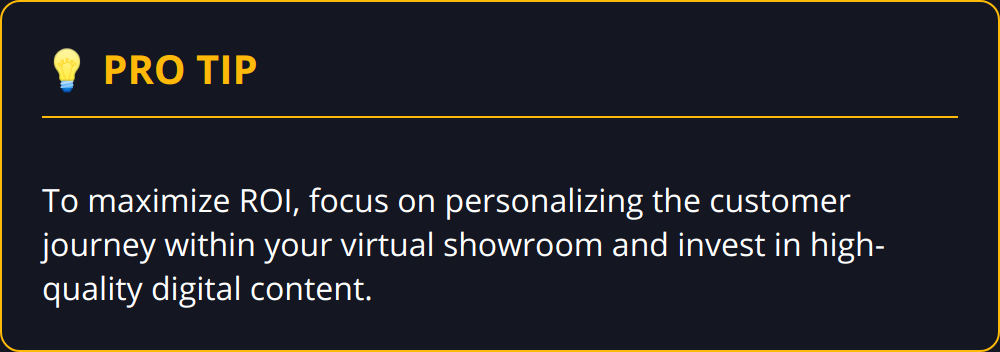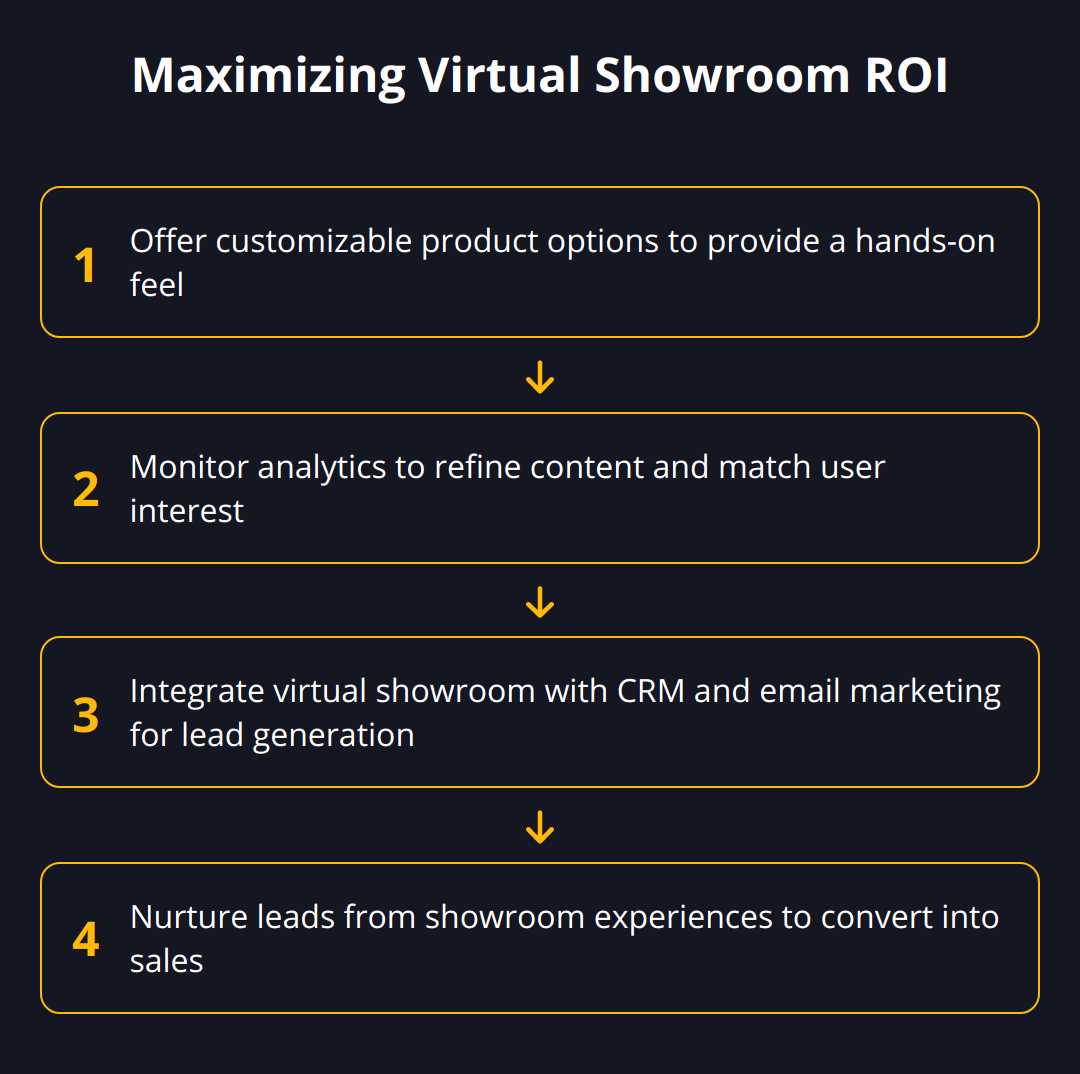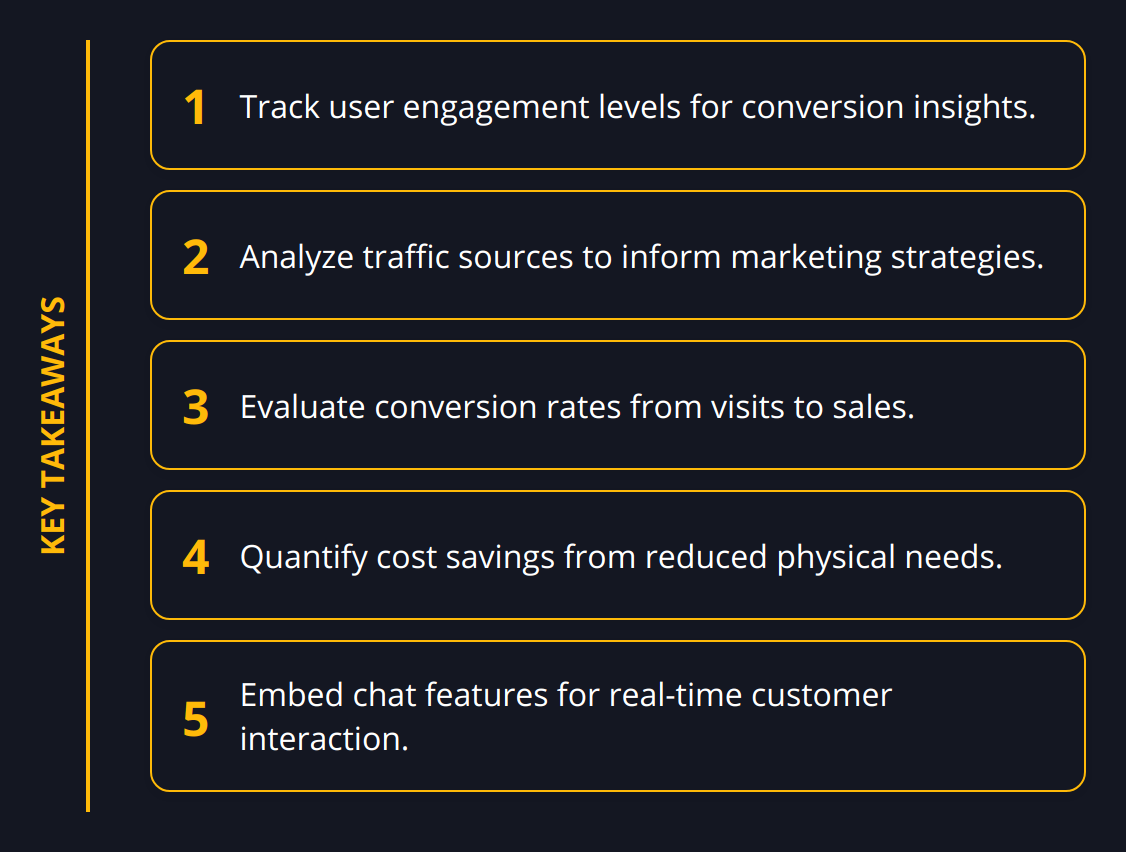We at newroom connect understand the transformative effect that virtual showrooms can have on your business’s bottom line. Measuring return on investment (ROI) in this digital space is both exciting and novel, yet with it comes a plethora of unique challenges and opportunities.
In this focused discussion, let’s explore the practical approaches that can amplify your virtual showroom’s ROI, cementing the value of this innovative model in today’s digital marketplace. With expert insights, we aim to bolster businesses looking to harness the full potential of their virtual displays.
Measuring Virtual Showroom ROI
When expanding into the realm of virtual showrooms, comprehending the ROI dynamics is imperative for justifying the investment and strategizing for profit maximization. With virtual showrooms, businesses encounter a different set of variables impacting ROI compared to traditional showrooms. Here, the investment often goes into high-quality digital content creation and platform functionality rather than physical space and inventory management. Nonetheless, the aim remains the same: maximizing the return on each dollar spent.
Virtual showrooms present an advantage by offering rich data insights into customer interactions. These can include the time spent on viewing specific products, the number of return visits, user navigation patterns, and engagement rates with interactive features. Monitoring these behaviors offers a goldmine of information that can directly correlate to purchasing tendencies and customer preferences. In essence, measuring ROI in virtual showrooms revolves around these key performance metrics.
For clear-cut ROI measurement, consider the following practical actions:
-
Track user engagement levels across your digital showroom. High interaction rates can indicate compelling content, which often leads to higher conversion rates.
-
Monitor and analyze traffic sources and user pathways. Understanding where your visitors come from and how they explore your showroom can inform better marketing strategies.
-
Evaluate conversion rates from leads to sales. The efficiency of your virtual showroom in turning visitors into customers is a direct ROI indicator.
-
Quantify cost savings in areas such as reduced need for physical space, decreased travel for clients, and lower staffing requirements.
-
Leverage analytics tools for real-time insights. Platforms with built-in analytics provide valuable data for continuously optimizing the virtual showroom experience, thus improving ROI.

While virtual showrooms reduce operational expenses, the initial investment in technology can be a concern for some. However, the benefits, such as reaching a global audience without geographical constraints and providing personalized customer experiences, are substantial factors that typically result in a robust ROI.
Incorporate these practical steps for leveraging the unique ROI opportunities of virtual showrooms:
-
Personalization is key – use data to tailor the virtual experience to individual user preferences, as personalized experiences heavily influence purchasing decisions.
-
Invest in quality content – the immersive nature of a virtual showroom is dependent on the quality of its 3D visuals and interactive elements.
-
Harness real-time analytics to refine and enhance user engagement strategies continually.
-
Keep an eye on environmental sustainability – not only does a virtual showroom reduce your carbon footprint, but it also resonates with the growing demographic of environmentally conscious consumers.

Remember, a well-implemented virtual showroom is more than just an online catalogue—it’s a dynamic, data-driven sales and marketing tool that, when leveraged correctly, can significantly boost ROI.
Elevate Virtual Showroom ROI
Elevating the ROI of a virtual showroom hinges on a meticulous approach to customer experience, a sophisticated use of analytics, and seamless integration with your sales strategy.
Creating an outstanding customer experience is paramount. Interactivity isn’t just a feature; it’s the backbone of a successful virtual showroom. Implement tools that encourage user participation, such as “try before you buy” features or customizable product options that offer a hands-on feel. Interactive elements not only captivate attention but also promote longer engagement times and deeper connections with your brand.
Paying close attention to analytics will unravel patterns in customer behavior that are critical for making informed decisions. Data on dwell time per product, click-through rates, and user interaction with virtual environment features provide actionable insights. By meticulously monitoring these metrics, you can continuously refine your content to match user interest, which often leads to a surge in sales conversions.

For an in-depth understanding of how to maximize your virtual showroom’s effectiveness through user interaction data, reviewing best practices on augmented reality showrooms could be vastly beneficial.
Integration with sales strategies should be a well-oiled machine. Your virtual showroom isn’t an isolated entity; it should be part of a wider ecosystem that includes your CRM, email marketing campaign, and live chat services. Use the virtual showroom as a lead generation machine that feeds into your sales funnel. Properly nurtured leads that originate from captivating showroom experiences translate to increased ROI.

Here are a few actionable insights:
-
Embed chat features to facilitate immediate inquiries, mimicking in-person sales interactions.
-
Offer virtual appointments to seamlessly transition interested visitors into active leads.
-
Provide downloadable resources within the showroom to capture lead information and fuel the sales pipeline.
Ultimately, integrating a virtual showroom with the broader sales strategy ensures that it becomes a robust conversion tool – not just a flashy showpiece. By emphasizing a smooth transition from virtual browsing to purchase, you strengthen customer relations and drive revenue growth.
Beyond these actionable insights, it is essential to recognize the crucial role robust content plays in securing an attractive ROI. Investing in high-quality, realistic 3D models and captivating narratives around your products can lead to an increase in user immersion and consequently, a higher conversion rate. Ensuring your digital showroom stays updated and reflects the latest in product innovation keeps your brand ahead of the curve.
As you advance in building or enhancing your virtual showroom, consider these points as your roadmap toward maximizing ROI. They are foundational in creating an environment that not only impresses but also delivers tangible business results.
Enhancing Virtual Showroom ROI
To solidify the success of a virtual showroom, focus on optimizing every facet for maximum user engagement. Effective design goes a long way, captivating visitors and encouraging them to explore your offerings more deeply. Moreover, when used strategically, promotional strategies become powerful tools for driving qualified traffic to your showroom. And don’t underestimate the power of well-trained sales teams; their expertise in navigating virtual spaces can turn a static showroom into a dynamic sales engine.
Starting from ground zero, ensure your showroom is designed with the user’s journey in mind. A layout that is intuitive and aligns with how people browse online can dramatically improve the time spent in your showroom. High-quality images, 3D product views, and responsive design are not just nice-to-have — they’re expected by today’s tech-savvy customers. The platform should load quickly and provide easy navigation to keep users engaged and less likely to bounce.
Promotion is equally important. You want a steady stream of visitors, and this is where SEO and comprehensive digital marketing strategies come into play. If your virtual showroom is the stage, consider social media and targeted ads as your loudspeaker. Think carefully about your audience and craft your campaign messages to resonate with their specific needs and interests.
Training your sales team to effectively use the virtual showroom can lead to significant increases in your return on investment. Here’s how:
-
Optimize navigation and accessibility: Ensure that your virtual showroom is user-friendly. Clear signposting and intuitive design keep visitors from becoming frustrated and clicking away.
-
Prioritize high-quality content: Invest in professional-grade photography and 3D models. Users are attracted to visual excellence, which can increase the likelihood of a sale.
-
Employ interactive tools: Features like virtual try-ons or product customizations engage users and provide a reason to return, boosting potential sales opportunities.
For promotions:
-
Harness social media: Announce updates, new releases, or feature specific products on platforms where your audience spends their time.
-
Deploy targeted advertising: Use available data to create ads that speak to the interests of your potential customers and lead them directly to your showroom.
-
Utilize content marketing: Share stories, blog posts, or case studies that highlight the benefits of your products and the virtual experience.
And for sales team training, focus on:
-
Regular product knowledge updates: Ensure that your team is as knowledgeable about your virtual offerings as they would be in a physical showroom.
-
Virtual sales tactics: Encourage your sales teams to engage with customers through live chat and virtual consultations to provide a personal touch.
-
Feedback loops: Cultivate a culture of continuous improvement by using sales team insights to optimize the showroom experience.

Adopting these insights ensures that your virtual showroom not only garners attention but also converts that attention into tangible sales. It’s about making your virtual environment as inviting and navigable as possible, employing targeted promotions to draw in the right crowd, and enabling your sales force to close deals with finesse.
Final Thoughts
Maximizing ROI in virtual showrooms represents a deliberate move towards digital innovation, one that rewards businesses making strategic use of data, content quality, and user experience. As we’ve highlighted, engagement levels, traffic analysis, and conversion tracking are pivotal in gauging success.

We at newroom connect have seen firsthand how these virtual environments can serve as a 24/7 gateway to global customers. The shift towards virtual commerce shows no signs of slowing, with businesses that invest in quality virtual experiences seeing higher engagement and sales. The future of commerce is clearly steering toward digital dominance, with virtual showrooms at the helm, enhancing customer engagement and driving sustainable growth.
Our platform stands as a testament to the power of immersive virtual experiences. By utilizing Unreal Engine 5 and Ready Player Me for realistic interactions and personalization, we enable businesses to launch captivating interactive experiences that truly resonate with their audience.
Here’s a succinct takeaway strewn with incentives for investing in virtual showroom technologies:
-
Deploy interactive, high-quality content to boost user engagement.
-
Employ real-time analytics for strategic insights.
-
Integrate immersive experiences within a wider marketing and sales strategy.
-
Embrace cost-saving and environmental benefits.
Virtual showrooms are not just a transition from physical to digital; they redefine how businesses interact with clients. They’re an opportunity to make a lasting impression that transcends the barriers of time and space.
Embrace the shift, and let newroom connect be your partner in this journey. Our commitment to your success is reflected in our expert support and scalable solutions. Tap into the transformative potential of virtual showrooms and expand your reach far beyond conventional limitations. With newroom connect, the future of virtual commerce is already at your fingertips. Visit our software platform for an in-depth look at how we can support your virtual journey.
As we look to the horizon, one thing is certain: virtual showroom technologies are more than a fleeting trend—they’re a strategic investment in the future of commerce. Businesses ready to make that leap will find themselves at the leading edge, well-positioned to captivate and grow their customer base in this new digital epoch.


